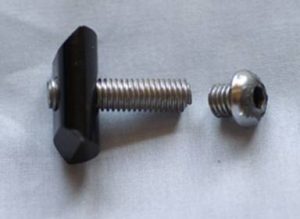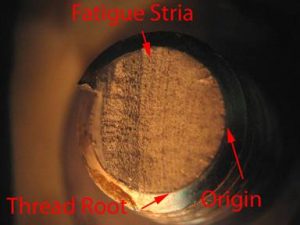Introduction
Product Liability Expert was asked to perform a failure analysis on a failed bicycle seat post. This seat post failed unexpectedly and the rider was injured. The failure analysis expert witness was sent the relevant parts and asked to determine the cause of failure. This work was essentially a bolt failure analysis.
Conclusion
The seat post failure was caused by a manufacturing defect. There was a deviation from the design. An unspecified bolt was substituted for the specified bolt. The callouts for chrome plated M8 X 1.25 bolts specify that only the final 13.0mm to 17.0mm of this bolt are to be threaded. The failed bolt had the entire shank threaded. The root of the threads of this faulty bolt acted as a stress riser and caused the bolt to fail due to metal fatigue.
Procedure
Failure Analysis: The collapse of the seat post occurred because the chrome plated M8 X 1.25 bolt that held the seat clamp failed. A root cause failure analysis was performed on this bolt.
Evaluate the Design: The geometry of the failed bolt was compared to the one called out by the design.
Results
Figure #1 shows the pieces of the failed seat post that were submitted for evaluation

Figure #1: Photograph of the pieces of the failed bicycle seat post that were submitted for the failure analysis.

Figure #2: Close up photograph of the failed chrome plated M8 X 1.25 bolt. This bolt held the clamping mechanism to hold the bicycle seat on the post.

Figure #3: Optical photomicrograph taken of the fracture surface and it includes the origin. This bolt failure is a fatigue failure. The fatigue crack initiated at the root of the rolled threads. The thread root acted as a stress magnifier (Mag 12X)

Figure #4: Drawing of the required chrome plated M8 X 1.25 bolt. It is important to note that the design specifies that only the final 13.0mm to 17.0mm of this bolt are to be threaded. This unthreaded portion of the bolt is required to create an “unthreaded shear area”.




